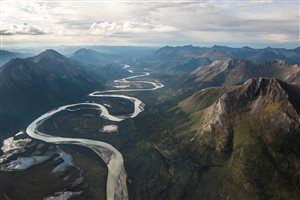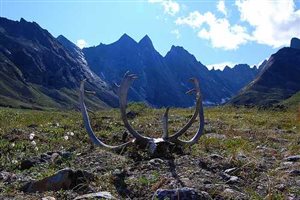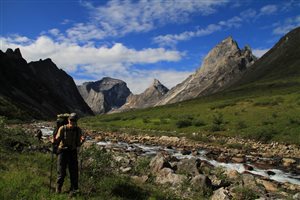Facts and Statistics

Apart from Dalton Highway, the park is situated away from any roads. There is only a single village in the vicinity – Anaktuvuk Pass. There are eight more villages on the perimeter of this reserve, although they have fewer than 400 residents. To put this into context, this hiking trail is located in total wilderness. It is almost the same size as Switzerland and lacks basic national park facilities, campgrounds, or visitors centers.
About This Park

It offers endless opportunities for backpackers, day hikers, and thru-hikers with wilderness adventure, which is not found in many places. There are less than 900 visitors every year, due to the remoteness and lack of navigable tracks. Due to that, you are likely to encounter Alaskan Caribou or Arctic wolf.
Accessibility

The north slopes and high country of Brooks Range are mainly wide open, several tundra, beautiful and treeless. Glacier carved peaks such as Mt. Igikpak and Arrigetch decorate the skyline. Below them are rivers used for canoeing such as Noatak and Alatna. To the north and west, the Nigu and Kobuk provide whitewater rafting with several challenging rapids.
Wildlife

Aquatic life includes pike, sheefish, trout, salmon, and grayling, in the lakes and rivers. The Western Arctic Caribou, which are more than 300,000, can be found in the park during the months of July. Whether you are just a hiker or a backpacker, you are sure going to enjoy the wildlife in the wilderness and make the trip a real backcountry experience.
Human History
The native Eskimos have lived in these mountain ranges for many years. They mainly lived off hunting the caribou and fishing in the rivers. Chipped stone, stone fences and tent rings can be found all over the park especially around the Nigu River. They provide a rich sense of history, unknown to outsiders in the fascinating landscape.
The southern part of the park, normally known as Koyukuk country was frequented by wilderness visionaries and gold rush pioneers such as Bob Marshall, who provide more history of this park through artifacts and stories.
Activities

Due to the remoteness of the park, most visitors are backcountry travelers for base camps or backpacking treks. It provides a great environment for hiking whether individually or in groups. Several outfitters offer guided trips during the summer that you can join. Whether you are going for a guided trip or as an independent traveler, a visit to this park requires advance reservations and careful planning.
Backpacking

It provides good scenery is as good as you can get. Since it is more than 150 miles from the closest village, and double that distance from the road, it provides solitude opportunities all over. This backpack is moderately difficult to hike. Therefore, you should expect more than 50-pounds of a pack on your back. Most of the weight is fuel and food. You should expect to hike around seven miles every day. In total, you will cover thirty miles. A steep climb, measuring around 1000 feet ascends over the pass.
The remainder of the route is mainly comprised of alpine terrain. Underfoot is mainly good, however, the first day and the last will be somehow wet and a little brushy. You will have several layover days to explore and savor your surroundings where you can lay down your pack.
Conclusion
The Caribou Tracks in Alaska provide an iconic backpack trip. The headwaters of Noatak and Alatna rivers provide a region of clear water, broad valleys, and rugged mountains. Several and unique wildlife make the route even more beautiful and inviting.
Trail Of The Caribou Documentary
allowfullscreen=”allowfullscreen”>Navigation
[jbio template=”bootbomb0″]

0 comments